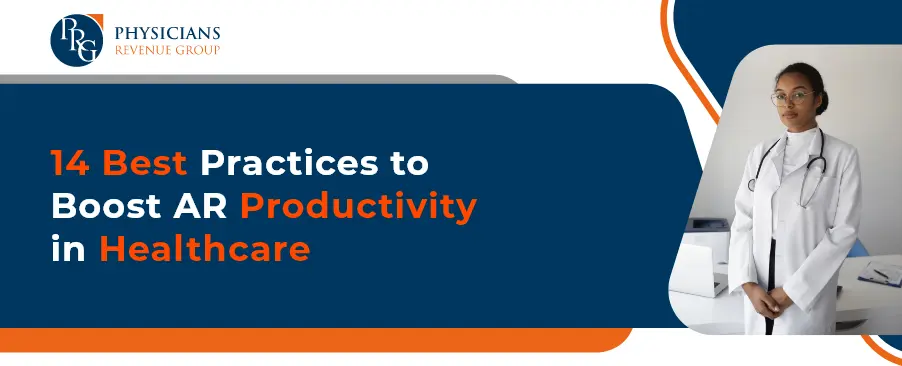
Email: info@prgmd.com | Call: +1 (630) 242-6474
Business hours: 9:00 to 5:00 | Monday to Friday
Email: info@prgmd.com | Call: +1 (630) 242-6474
Business hours: 9:00 to 5:00 | Monday to Friday

Table of Contents
ToggleAccounts receivable is the outstanding reimbursement amount owed to the healthcare providers for the patient treatments and services. The AR process caters to the overall financial management of a healthcare practice. Whether the financial responsibility falls on the patients or their insurance providers, healthcare professionals must stay on top to boost AR productivity. It can be done by outsourcing medical billing services and focusing on collections for the AR amounts.
The longer AR goes unpaid, the less likely it is that healthcare providers will receive payments at all. Moreover, after 120 days, providers can only expect 10 cents per dollar owed in total.
Ideally, the AR cycle starts with the healthcare providers billing patients or patients’ insurance providers. Although it is indicated as money owed, ARs are not assets. Furthermore, the providers classify AR in terms of their age:
Not being able to collect payments or reimbursements lengthens the AR cycles and risks revenue leakage. Revenue leakage is when the treatment or care provided by healthcare professionals is not reimbursed, making providers suffer a loss.
For instances like this, what are some ways to boost AR productivity?
Healthcare professionals must verify patient insurance eligibility before performing services or giving treatments. On-time insurance verification reduces the likelihood of rejections and claims denials, resulting in timely payments. Furthermore, patient insurance verification ensures the correct capturing of insurance information during patient registration.
To boost AR productivity, healthcare providers must communicate openly with patients regarding finances. Clearly defined payment terms will ensure that providers are more likely to avoid delays with AR. In most instances, healthcare providers can reduce delayed or delinquent payments by ensuring that all payment expectations are clear for patients before treatment. Creating a payment responsibility document for new patients to sign on their first appointment gives them a clear view and idea of what is expected from them regarding payments.
Accuracy in medical coding ensures timely and accurate payments and helps boost AR productivity. Coding errors lead to claim denials, which result in payment delays. Healthcare professionals must have an expert and certified coding team that stays up-to-date with the current coding regulations and guidelines.
Payment delays are an undeniable fact in the medical AR recovery process. Therefore, it is vital that all of the outstanding and unpaid accounts are managed adequately. Close to 1.5 percent is written off as a bad debt, while 93 percent have to deal with payment delays. The longer outstanding accounts are left untouched, the less likely they will be paid. To boost AR productivity, it is vital to notify patients frequently, through phone calls and letters, even using stronger collection processes – if and when necessary.
The main goal of running constant AR reports is to boost AR productivity by keeping the accounts receivable days low, which is most effective for the healthcare RCM. The particular procedure necessitates continuous tracking of accounts receivables. Moreover, it is helpful to carefully analyze the data from month to month to highlight the disturbing trends or the ongoing issues with payment collections. The AR report must examine things including:
One way your practice can boost AR productivity is by requiring patients to pay out the co-pays or the subsequent bills right in the office. Doing so will massively cut back on the accounts receivable for healthcare practices. Some medical practices require upfront deposits and percentages for treatments or procedures. Doing so does not cut down on a number of accounts, however it can cut down the monies owed.
Ideally, upfront payments become revenue, supporting the cash flow for healthcare providers.
Monitoring claim denials and appeals is vital to boosting AR productivity. It helps in the identification of trends and patterns of the denials. Healthcare practices must keep track of appeals and denials, as it helps analyze data to identify the root causes. Overall, monitoring of claims helps improve the RCM process and reduce denials.
Facilitating patients by offering them multiple payment plans to improve collections can also help boost AR productivity. Furthermore, creating a well-rounded system to manage payment plans and then implementing them correctly is vital for the financial health of your healthcare practice.
To boost AR productivity, providers or their billers can increase the frequency of billing cycles. The more frequently/quickly payers are billed for the services, the sooner those outstanding amounts can be paid. That said, many providers still send out bills once a month, which can introduce delays with accounts receivable.
It will be good to increase the frequency of billing cycles to speed up the processes. For instance, your practice can submit or mail insurance and patient invoices weekly.
Efficiency and accuracy in medical billing are essential to boost AR productivity and keep AR days as low as possible. Something as tiny as a claim error can delay payment from insurance providers for weeks or months. If your in-house billing procedures and team are not as efficient as they should be – consider outsourcing to third-party medical billing companies.
Share:
Categories
Recently Added

What is an ABN in medical billing?

What does a Clearinghouse do During Claims Submission?

What is EOR in Medical Billing?
We Would Love to Assist You!
We treat your data confidentially and don’t share any information with a third party.